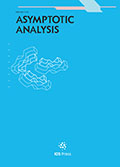Authors: Agarwal, Ravi P. | O'Regan, Donal | Wong, Patricia J.Y.
Article Type:
Research Article
Abstract:
We consider the following system of integral equations ui (t)=μ∫0 1 gi (t,s)f(s,u1 (s),u2 (s),…,un (s)) ds, t∈[0,1], 1≤i≤n, where μ>0, the function f may take negative values and f(·,u1 ,u2 ,…,un ) may be singular at uj =0, j∈{1,2,…,n}. Our aim is to establish criteria such that the above system has a constant‐sign solution. To illustrate the generality of the results obtained, application to a well known boundary value problem is included. We also extend the above problem to that on the half‐line [0,∞) ui (t)=μ∫0 ∞ gi (t,s)f(s,u1 (s),u2 (s),…,un (s)) ds, t∈[0,∞), 1≤i≤n.
Keywords: semipositone, system of singular integral equations, constant‐sign solutions, boundary value problems
Citation: Asymptotic Analysis,
vol. 43, no. 1-2, pp. 47-74, 2005
Price: EUR 27.50





